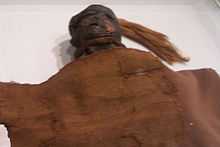Yde Girl
Coordinates: 53°05′49″N 6°35′06″E / 53.09694°N 6.58500°E[1]

Yde Girl (i) ![]() [ ɪdə ] is a bog body found in the Stijfveen peat bog near the village of Yde, Netherlands. She was found on 12 May 1897 and was reputedly uncannily well-preserved when discovered (especially her hair), but by the time the body was turned over to the authorities a fortnight later it had been severely damaged and deteriorated.
[ ɪdə ] is a bog body found in the Stijfveen peat bog near the village of Yde, Netherlands. She was found on 12 May 1897 and was reputedly uncannily well-preserved when discovered (especially her hair), but by the time the body was turned over to the authorities a fortnight later it had been severely damaged and deteriorated.
Examination

Carbon-14 tests have indicated that Yde Girl died between 54 BCE and 128 CE at an approximate age of 16 years. She had long reddish blond hair, but one side of her head had been shaved before she died. Recent studies of Windeby I, however, have suggested that the shaved hair phenomenon in some bog bodies may simply attest to one side of the head being exposed to oxygen slightly longer than the other. Scans have shown that she suffered from a spine condition known as scoliosis.
The body was found clad in a woolen cape and with a woolen band, made in a braiding technique known as sprang, wrapped around the neck, suggesting she was executed or sacrificed. There was also a stab wound in the area of her collarbone, but that was not determined as the cause of death. As with most bog bodies, the skin and features are still preserved because of the tannic acid in the marsh water. When Yde Girl was excavated, the diggers accidentally caused a wound to the skull. Only the torso of the girl, the head, the right hand and the feet were found. The rest of her body was not preserved.
Exhibit

The Yde Girl was put on display at a museum and further study was not carried out on the remains until 1992. Richard Neave, of Manchester University, took a CT scan of the skull of Yde Girl and determined her age, both anatomically and historically. The Yde Girl became internationally known when Neave made a reconstruction of her head, using techniques from plastic surgery and criminal pathology.[2] Yde Girl and her modern reconstruction are displayed at the Drents Museum in Assen.
See also
- Bog body
- Kayhausen Boy, found in 1922, believed to have been sacrificed for physical deformities.
- Clonycavan Man, found in 2003 three months before Old Croghan Man, dating to the first centuries BCE.
- Grauballe Man, found 1952 in Nebelgård Mose, a bog in Jutland, Denmark.
- Haraldskær Woman, 5th century BCE, found 1835 in a peat bog in Jutland, Denmark.
- Lindow Man, found 1984, also reconstructed by Richard Neave.
- Tollund Man, 3rd - 2nd century BCE.
- Bocksten Man, found 1936, Sweden.
- Weerdinge Men, from 160-220 BCE, were two naked bog bodies found in Drenthe, Netherlands in 1904.
References
- ↑ van der Sanden, Wijnand (1990). Mens en moeras: veenlijken in Nederland van de bronstijd tot en met de Romeinse tijd. Assen: Drents Museum. pp. 61 Fig 12. ISBN 90-70884-31-3.
- ↑ Prag, John; Neave, Richard (1997). Making faces: using forensic and archaeological evidence [Bodies from the Bog]. London: British Museum. pp. 157–171. ISBN 0-7141-1743-9.
External links
- Yde Girl - as discovered and facial reconstruction at James M. Deem's Mummy Tombs site.
- National Geographic September 2007: "Tales From the Bog"
- Reconstruction of the head of Yde Girl by Richard Neave
| |||||||||||